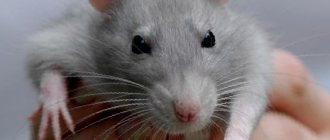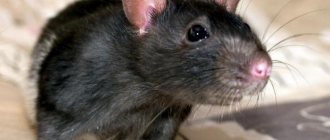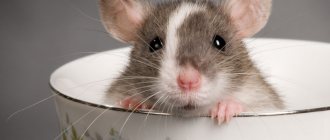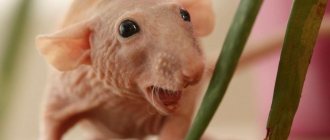- Wild animals
- >>
- Mammals
The Gambian rat is one of the largest species in the rodent family, but also one of the friendliest. Due to the large size of Gambian rats, they pose a serious threat to native species (especially nesting species) and crops, especially if they invade mainland Florida.
Structure and appearance
Gambian rats belong to the family of nezomyids from the order of rodents. This is a large animal the size of an average dog. The length of the body reaches 45 cm, and together with the tail - 91 cm. The average weight of the mammal is 1.5 kg, and for the largest individuals - 2.8 kg.
The Gambian rat has other names - hamster rat or marsupial rat - because it has cheek pouches. Their capacity is about 100 ml. A rodent can carry a huge amount of food into them.
Externally, African rats are similar to their European counterparts. They have a pointed muzzle, small eyes, and gray-brown hard fur. The long tail is covered with scales and very sparse coarse hairs. Interestingly, two-thirds of its length is dark in color, and the rest, towards the end, is light. The fur on the belly is slightly lighter than on other parts of the body.
The rather large ears are oval shaped and stand erect. The Gambian rat's eyes are surrounded by a dark edging - this is its main difference from other relatives. The nose and paws are pink, and the whiskers are dark.
Sexual dimorphism is weakly expressed - males are quite a bit larger than females. In individuals that live in captivity, there may be a slight pattern on the coat - stripes or spots in the hips and shoulder girdle, as well as on the head. Some domestic Gambian rats have unnaturally dark fur, closer to black.
Interaction with people
In many African giant countries, marsupials are valued as an important product.
They are easily tamed as pets. However, they were linked to the monkeypox outbreak in the US in 2003 and have since been banned from import to the US.
Ability to detect mines and tuberculosis aroma
These rats also become useful in some areas for detecting mines, as their keen sense of smell is very effective in detecting explosives, and they are light enough not to blow up any of the mines. The rats are trained by APOPO, a non-profit social enterprise based in Tanzania.
The method of training rats to detect mines was conceived and developed by Bart Witjens from Belgium. Training runs at four weeks of age, when the rats are processed to acclimate them to people and are exposed to a variety of sights and sounds. They learn to associate the clicker with the food reward of banana paste or banana peanuts. They are then trained to point to a hole with TNT in it by sniffing it out for five seconds. Then they learn to find the correct hole in the line of holes. Finally, the rat is trained to wear a harness and practice outdoors on the lead by finding inactivated shafts under the soil. At the end of their training they are tested: they must find all the mines in an area of 400 square meters that has been selected with the mines inactivated. This is a blind survey: their miners don't know where the mines are. If they succeed, they are certified as bomb-sniffing rats.
Duration and lifestyle
In the wild, African rats live for approximately 3 years. In their natural environment they have no enemies who would prey on this particular species. At home, representatives of this species can live longer - 5-7 years.
The animal is active mainly at night and sleeps during the day. When dusk falls, the Gambian rat goes in search of food. She stuffs the cheek pouches and brings them home. Rodents do not tolerate encroachment on their territory and jealously defend their nests.
Gambian rats are friendly towards humans and never attack them. Aggression is only possible if the animal has to defend itself.
Due to severe stress or fear, a rat may bite its offender.
Habitat
The Gambian rat lives mainly in the central parts of Africa. Rodents inhabit the territory from the southern borders of the Sahara Desert to the province of KwaZulu-Natal in the Republic of South Africa. They live in small groups of about 20 individuals in savannas and temperate zones.
Gambian rats prefer to live in wooded areas, as they usually use hollows in trees as homes. In the absence of such, rodents dig their holes directly in the ground. They can also live in mountainous areas. In this case, rock crevices serve as their home.
African rats are often found in close proximity to human settlements. They settle in cellars and basements of houses. Local residents do not like being around rodents because they quickly destroy food supplies and damage property.
Interesting Facts
Gambian rats are amazing animals. This is confirmed by the following facts:
- This species is considered one of the largest among rodents.
- Thanks to the large capacity of the cheek pouches, the rodent is able to carry about 3 kg of food in 1 hour.
- Gambian rats have poor vision but have an excellent sense of smell. They know how to search for unexploded mines, so they are often used as sappers.
- Gambian rodents can detect tuberculosis bacteria in saliva samples with 99% accuracy. If a laboratory technician takes an average of 3-4 days to study one analysis, then a rat can process about 100 tubes in 20-30 minutes. When she finds the tuberculosis bacilli, she freezes for a few seconds.
APOPO - it sounds proud
The Belgian Bart Witjens didn't care. He was so impressed by the statistics of deaths and injuries from mines that in 1998 he founded the Belgian non-profit organization APOPO (translated into Russian as the development of means for detecting anti-personnel mines).
As a child, Bart kept rats and other rodents, and while studying at university he learned about their ability to detect mines and explosives by smell. In addition, unlike a dog, a rat will not be able to accidentally activate the ammunition: the rodent is too light.
Bart Witjens with one of the sappers (photo source)
So what do we have? If you train rats, you can end up with an inexpensive, well-trained and massive army of tailed sappers capable of detecting anti-personnel and anti-tank mines. And without expensive equipment.
African (Gambian) marsupial rats (Cricetomys gambianus) were chosen for the role of sappers from the entire variety of rodents. Why them? Africa is their home. They are well oriented and accustomed to hot climates. Hardy and disease resistant. Compared to other relatives, they live quite long. But most importantly, they have an excellent sense of smell.
Natural enemies
In the wild, Gambian rats are sometimes attacked by large birds or predators. However, this is not so easy to do - rodents usually gather in groups, and together they are able to fend for themselves.
The greatest danger to rodents is humans. After all, their meat has a pleasant taste, and various dishes are prepared from it. Rats living near villages and cities are exterminated en masse because they cause enormous damage:
- destroy the soil structure;
- eat crops, grain and vegetable reserves;
- clog the sewer.
Features of keeping at home
These animals quickly adapt to any conditions. They can be kept in our climate
However, you should pay attention to the fact that they do not tolerate sudden temperature changes.
For a comfortable existence, they need to equip a spacious enclosure with a metal (and always flat!) floor. It is desirable to have several floors with various loopholes and holes. At the same time, it is better to avoid materials such as wood or plastic in the design of the enclosure.
How many floors are there in your rat enclosure? Poll Options are limited because JavaScript is disabled in your browser.
Reproduction and offspring
Sexual maturity in these rodents occurs at six months of age. In nature, the mating season for Gambian rats occurs during the warm season. The male courts the female, after which mating occurs. Pregnancy lasts about a month, childbirth is easy.
One litter can contain from one to five rat pups. Newborns have no fur on their bodies and their eyes are closed. They open 20 days after birth. The ears of babies up to two weeks of age are folded, so they cannot hear anything.
Determining the sex of a rodent is quite simple. Already at the age of 9–10 days, nipples can be seen on the abdomen of female rats. Males do not have them.
The mother feeds the offspring with milk for 4 weeks. During this time, the cubs gradually grow hair and learn to eat.
- Males do not participate in raising the young, and sometimes even eat them.
- Females have a well-developed maternal instinct. They can take care not only of their own litter, but also of the offspring of other rats.
Brief description of the possum
An opossum is a mammal belonging to the marsupial class. Its closest relative is the rat possum.
The body of the animal is up to 50 cm in length, and the snout is elongated and conical. The tail is long, up to 55 cm, prehensile, usually naked. The body is covered with thick, short fur of indeterminate color, usually gray-brown, rarely almost black. It has short legs and well-developed teeth.
The opossum's blood is an antidote to rattlesnake venom, allowing it to hunt almost all types of rattlesnakes, but there are exceptions. They are found in southeastern Canada, the United States and Argentina.
Opossums live everywhere - in mountains and forests, in steppes and semi-deserts, they live on the ground, less often in trees. Activity occurs at night, at dusk. They are omnivores, but do not neglect insects. Opossums are solitary animals and gather in groups only during mating season. Some people carry their babies in bags, but not everyone has one.
An interesting behavioral trait of the opossum is its ability to emit an unpleasant odor, pretending to be dead when encountering a predator, which often saves its life.
Population and species status
In the US state of Florida, a population of Gambian rats appeared in the early 2000s. One breeder, by an absurd accident, released 9 of his charges into the wild. As a result, after a few years, rodents spread everywhere. Experts suggest that these animals became carriers of the monkeypox virus in the state. In this regard, the government has banned the distribution and sale of Gambian rats.
Today, American services are trying with all their might to destroy the rodent population, because they get into sewer manholes and damage pipes. Rats spread infections and eat food supplies stored in barns. Rat poison is used to kill animals. Despite the efforts of the American authorities, they were unable to completely get rid of the rodents.
Is it possible to keep a Gambian rat at home?
The Gambian rat has long won the hearts of people. These are excellent pets that readily respond to care with friendliness. In addition, they are very smart and trainable.
Place for a cage
Gambian rats do not tolerate temperature changes well. It is advisable to allocate a room for the rodent where the thermometer is constantly within 20-23 degrees. The cage is installed in the back of the room so that the animal is not exposed to direct sunlight. The rat's home should be protected from drafts.
Cage requirements
To keep a Gambian rat at home you will need a spacious cage or enclosure. It should be made of durable steel grating. Otherwise, the rodent will break the bars and escape. For the same reason, plastic and wooden structures are not suitable.
Inside it is necessary to place a house where the Gambian rat will hide and sleep. You will also need a feeder, a water bowl and a hammock. For entertainment, you can install a labyrinth in the cage.
A thick layer of litter is poured onto the bottom, which is usually used as:
- hay;
- granulated sawdust;
- wood shavings.
Diet at home
The health of the Gambian rodent depends on the quality of nutrition. It should not be overfed. Food is placed in the feeder in the morning and evening. At first it may seem that these rats are very gluttonous. However, they hide most of their food in secluded places - they make supplies for themselves. If the feeder quickly becomes empty, there is no need to refill it.
The Gambian rat eats almost everything:
- vegetables other than turnips and radishes;
- fruits other than citrus fruits;
- grain mixtures;
- beans in small quantities;
- boiled lean meat – 2 times a week;
- cottage cheese;
- boiled fish without bones;
- eggs.
Attention! It is important to ensure that the drinking bowl is always filled with clean water. Gambian rats are not given any other drink.
Home content
These rat giants are distinguished by their love of tenderness and affection. They are friendly and good-natured, and are also able to sincerely become attached to their owner. But keeping a pet is a lot of trouble. Here are the basic rules for keeping a marsupial rat in captivity:
- The animal must be kept in a spacious metal enclosure.
- The enclosure should be installed in a warm room with dim artificial lighting, without direct sunlight.
- You can use sawdust, dry grass or wood chip pellets as bedding to cover the bottom of the enclosure.
- Females and males must live separately. The only exception is the period of raising baby rats. At this time, the mother should be close to the cubs, regardless of their gender.
- It is necessary to place all kinds of labyrinths, hammocks, etc. in the home.
- Items made of wood and plastic should be avoided - the rat will chew them off.
- The rat needs a daily walk, as well as regular games with the owner and frequent tactile contact.











